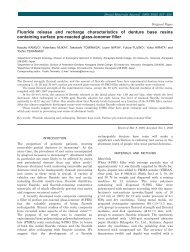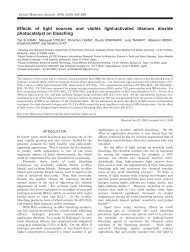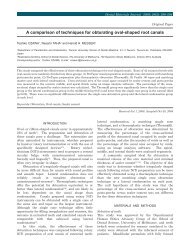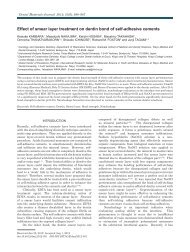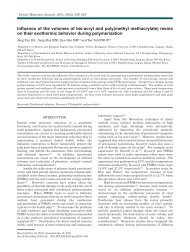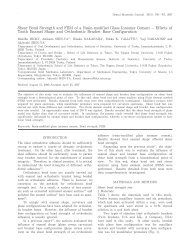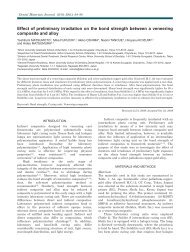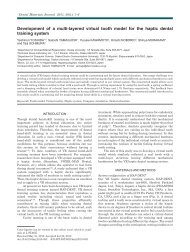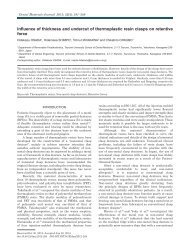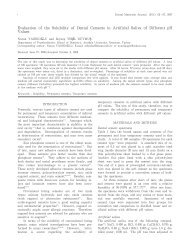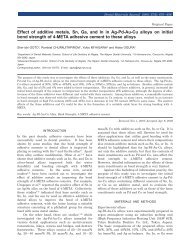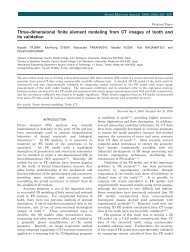Creep of experimental short fiber-reinforced composite resin
Creep of experimental short fiber-reinforced composite resin
Creep of experimental short fiber-reinforced composite resin
Create successful ePaper yourself
Turn your PDF publications into a flip-book with our unique Google optimized e-Paper software.
Dental Materials Journal 2012; 31(5): 737–741<br />
<strong>Creep</strong> <strong>of</strong> <strong>experimental</strong> <strong>short</strong> <strong>fiber</strong>-<strong>reinforced</strong> <strong>composite</strong> <strong>resin</strong><br />
Sufyan GAROUSHI 1,2 , Muhammad KALEEM 3 , Akikazu SHINYA 1,4 , Pekka K.VALLITTU 1 , Julian D. SATTERTHWAITE 3 ,<br />
David C. WATTS 3 and Lippo V. J. LASSILA 1<br />
1<br />
Department <strong>of</strong> Biomaterials Science and BioCity Turku Biomaterials Research Program, Institute <strong>of</strong> Dentistry, University <strong>of</strong> Turku, Lemminkäisenkatu<br />
2, FI-20520 Turku, Finland<br />
2<br />
Department <strong>of</strong> Restorative Dentistry & Periodontology, Institute <strong>of</strong> Dentistry, Libyan International Medical University, Benghazi, Libya<br />
3<br />
Biomaterials Research Group, School <strong>of</strong> Dentistry, The University <strong>of</strong> Manchester, Higher Cambridge Street, Manchester M15 6FH, UK<br />
4<br />
Department <strong>of</strong> Crown and Bridge, School <strong>of</strong> Life Dentistry at Tokyo, The Nippon Dental University, 1-9-20 Fujimi, Chiyoda-ku, Tokyo 102-8159,<br />
Japan<br />
Corresponding author, Akikazu SHINYA; E-mail: akikazu_dds@msn.com<br />
The purpose <strong>of</strong> this study was to investigate the reinforcing effect <strong>of</strong> <strong>short</strong> E-glass <strong>fiber</strong> fillers oriented in different directions on<br />
<strong>composite</strong> <strong>resin</strong> under static and dynamic loading. Experimental <strong>short</strong> <strong>fiber</strong>-<strong>reinforced</strong> <strong>composite</strong> <strong>resin</strong> (FC) was prepared by mixing<br />
22.5 wt% <strong>of</strong> <strong>short</strong> E-glass <strong>fiber</strong>s, 22.5 wt% <strong>of</strong> <strong>resin</strong>, and 55 wt% <strong>of</strong> silane-treated silica fillers. Three groups <strong>of</strong> specimens (n=5) were<br />
tested: FC with isotropic <strong>fiber</strong> orientation, FC with anisotropic <strong>fiber</strong> orientation, and particulate-filled <strong>composite</strong> <strong>resin</strong> (PFC) as a<br />
control. Time-dependent creep and recovery were recorded. ANOVA revealed that after secondary curing in a vacuum oven and<br />
after storage in dry condition for 30 days, FC with isotropic <strong>fiber</strong> orientation (1.73%) exhibited significantly lower static creep value<br />
(p
738 Dent Mater J 2012; 31(5): 737–741<br />
<strong>fiber</strong> fillers could reduce the creep value <strong>of</strong> <strong>composite</strong><br />
<strong>resin</strong>s.<br />
MATERIALS AND METHODS<br />
Materials<br />
Materials used in this study are listed in Table 1. The<br />
dimethacrylate <strong>resin</strong> matrix (Bis-GMA 67 wt% [bisphenol<br />
A-glycidyl dimethacrylate], TEGDMA 32.3 wt%<br />
[triethylene glycol dimethacrylate], CQ and DMAEMA<br />
0.7 wt% [camphorquinone and dimethylaminoethyl<br />
methacrylate]) consisted <strong>of</strong> 50 wt% <strong>of</strong> SiO 2 nan<strong>of</strong>iller<br />
(Hanse Chemie, Germany; particle size=20 nm).<br />
Reinforcement material was everStick <strong>fiber</strong>s (Stick<br />
Tech Ltd., Turku, Finland), which were E-glass <strong>fiber</strong>s<br />
pre-impregnated with Bis-GMA and PMMA [poly(methyl<br />
methacrylate); M w=220.000].<br />
Experimental <strong>short</strong> <strong>fiber</strong> <strong>composite</strong> <strong>resin</strong> (FC)<br />
was prepared by mixing 22.5 wt% <strong>of</strong> <strong>short</strong> E-glass<br />
<strong>fiber</strong>s (3 mm in length) to 22.5 wt% <strong>of</strong> dimethacrylate<br />
<strong>resin</strong> matrix. Then, 55 wt% <strong>of</strong> BaAlSiO 2 radio-opacity<br />
particulate fillers (Specialty Glass, USA; 3±2 μm in size),<br />
which were silane-treated 23) , were gradually added to<br />
the mixture. Mixing was performed using a high-speed<br />
mixing machine (SpeedMixer, DAC, Germany; 3500<br />
rpm) for 5 min. Therefore, the FC <strong>composite</strong> <strong>resin</strong> was<br />
a dimethacrylate-based <strong>resin</strong> matrix containing PMMA<br />
linear polymer phase, such that a semi-IPN polymer<br />
matrix would be formed by polymerization.<br />
For control, a commercial particulate-filled <strong>composite</strong><br />
<strong>resin</strong>, Z250 (3M ESPE, USA; Bis-GMA, UDMA, Bis-EMA,<br />
79 wt% filler) <strong>of</strong> shade A2, was used.<br />
oriented into two horizontal directions);<br />
and<br />
Group C: Commercial particulate-filled <strong>composite</strong><br />
<strong>resin</strong> (PFC).<br />
Specimens were cured using one <strong>of</strong> these methods:<br />
(1) Polymerization by handheld light curing unit (LCU)<br />
with an irradiance <strong>of</strong> 550 mW/cm 2 (Optilux 500, Kerr,<br />
CT, USA) for 80 s from both top and bottom surfaces;<br />
or (2) Secondary curing in a visible light curing (VLC)<br />
vacuum oven (Visio Beta, ESPE, Germany) for 15 min.<br />
Cured specimens were either dry-stored or water-stored<br />
at a constant temperature (37°C) for 30 days until creep<br />
testing.<br />
Static and dynamic creep tests<br />
For the static creep test, specimen was placed in a<br />
loading device (Fig. 1) and subjected to a constant stress<br />
<strong>of</strong> 20 MPa for 2 h, followed by 2 h <strong>of</strong> strain recovery after<br />
load removal. During the entire loading and unloading<br />
time, applied load was monitored and deformation was<br />
measured as per described in previous studies 24-26) .<br />
For the dynamic creep test, a universal testing<br />
machine (Z020, Zwick/Roell GmbH & Co. KG, Ulm,<br />
Germany) was used. Loading cycles <strong>of</strong> 4 s each were<br />
accomplished repeatedly and reliably according to the<br />
preset test parameters for load amplitude and load<br />
Experimental groups<br />
Solid cylindrical specimens (4×6 mm), according to each<br />
<strong>experimental</strong> group’s composition, were prepared using<br />
split steel molds. There were three <strong>experimental</strong> groups<br />
(n=5) in this study as follows:<br />
Group A: FC <strong>composite</strong> <strong>resin</strong> with isotropic <strong>fiber</strong><br />
orientation (3D <strong>fiber</strong> orientation: <strong>fiber</strong>s<br />
oriented into two horizontal directions and<br />
one vertical direction);<br />
Group B: FC <strong>composite</strong> <strong>resin</strong> with anisotropic <strong>fiber</strong><br />
orientation (2D <strong>fiber</strong> orientation: <strong>fiber</strong>s<br />
Fig. 1<br />
Loading device for static creep test.<br />
Table 1<br />
Materials used in this study<br />
Composite <strong>resin</strong> Manufacturer Lot number Composition<br />
Z250 3M ESPE, St. Paul, MN, USA 20090707 Bis-GMA, UDMA, Bis-EMA<br />
Short <strong>fiber</strong> <strong>composite</strong>, FC Experimental 2100524-D7-022 Bis-GMA, TEGDMA<br />
everStick Stick Tech Ltd., Turku, Finland 2050426-ES-125 PMMA, Bis-GMA<br />
PMMA: Poly(methylmethacrylate), M w =220.000<br />
Bis-GMA: Bisphenol-A-glycidyl dimethacrylate<br />
TEGDMA: Triethylene glycol dimethacrylate<br />
UDMA: Urethane dimethacrylate<br />
Bis-EMA: Bisphenol-A-polyethylene glycol diether
Dent Mater J 2012; 31(5): 737–741<br />
739<br />
duration. During each loading cycle, stress increased<br />
and then decreased between 1 MPa and 50 MPa at a<br />
constant rate. Load and displacement data as functions<br />
<strong>of</strong> time for 450 loading cycles were recorded within 30<br />
min. Load was recorded in increments <strong>of</strong> 1 N, while<br />
increments <strong>of</strong> time and displacement were 0.01 s and 1<br />
μm respectively.<br />
Load, displacement, and time data were processed<br />
using Matlab R2007b s<strong>of</strong>tware. Amongst the stress<br />
values recorded during the loading phase <strong>of</strong> each cycle,<br />
only the creep strain and time data corresponding to<br />
35 and 36 MPa <strong>of</strong> stress were used for this study. An<br />
optimized plot <strong>of</strong> creep strain-versus-time was then<br />
obtained based on a quadratic regression analysis <strong>of</strong><br />
the selected data. Average dynamic creep values for<br />
each time moment were calculated from the different<br />
<strong>experimental</strong> runs.<br />
Statistical analysis<br />
Statistical analysis was performed using SPSS version<br />
10.0 (SPSS Inc., Chicago, IL, USA). Static and dynamic<br />
creep data were statistically analyzed using analysis <strong>of</strong><br />
variance (ANOVA) followed by Tukey’s post hoc test at<br />
significance level <strong>of</strong> 0.05 to determine the differences<br />
among the groups. Types <strong>of</strong> <strong>composite</strong>, curing method,<br />
and storage condition (dry- or water-stored) were used<br />
as independent factors.<br />
RESULTS<br />
The mean and standard deviation values <strong>of</strong> static and<br />
dynamic creep strains <strong>of</strong> dry- and water-stored specimens<br />
are summarized in Tables 2a and 2b respectively.<br />
In Table 2a for dry-stored specimens, ANOVA<br />
revealed that the static creep strain values <strong>of</strong> FC after<br />
secondary curing in vacuum oven (Group A: 1.73% and<br />
Group B: 2.07%) were significantly lower than PFC<br />
(2.54%) (p0.05).
740 Dent Mater J 2012; 31(5): 737–741<br />
in significant differences in both static and dynamic<br />
creep strain values among Groups A to C (p>0.05). For<br />
both curing methods, there were also no statistically<br />
significant differences (p>0.05) in both static and<br />
dynamic creep strain values between Groups A and B <strong>of</strong><br />
different <strong>fiber</strong> orientations.<br />
In Table 2b for water-stored specimens, ANOVA<br />
revealed that the influences <strong>of</strong> curing method (OLC)<br />
and storage condition (water storage) were higher in FC<br />
specimens than in PFC.<br />
DISCUSSION<br />
The creep-recovery pr<strong>of</strong>iles <strong>of</strong> the <strong>resin</strong> <strong>composite</strong>s<br />
investigated in this study followed the typical stages<br />
<strong>of</strong> deformation and recovery generally observed for<br />
polymeric materials 24) . Therefore, the time-dependent<br />
creep deformation and recovery measurement method<br />
used in this study provided an insight not only into the<br />
material’s ability to resist stresses without catastrophic<br />
failure, but also how stresses were accommodated by<br />
compliance through viscoelastic behavior and viscous<br />
fluidity when under constant dynamic loading, and the<br />
degree to which the material would relax towards its<br />
original configuration when the load was removed 25,26) .<br />
Effect <strong>of</strong> <strong>fiber</strong> length<br />
It was favorably reported that the use <strong>of</strong> <strong>short</strong> glass <strong>fiber</strong>s<br />
with a semi-IPN matrix in restorative filling <strong>composite</strong><br />
<strong>resin</strong>s resulted in improved mechanical properties, loadbearing<br />
capacity, and polymerization shrinkage 18–21) .<br />
For this reason, the hypothesis <strong>of</strong> this study was that<br />
<strong>short</strong> E-glass <strong>fiber</strong> fillers with a semi-IPN <strong>resin</strong> matrix<br />
could reduce the creep value <strong>of</strong> <strong>composite</strong> <strong>resin</strong>s.<br />
The reinforcing effect <strong>of</strong> <strong>fiber</strong> fillers is due to<br />
stress transfer from polymer matrix to <strong>fiber</strong>s, when<br />
the <strong>fiber</strong> length is equal to or greater than the critical<br />
<strong>fiber</strong> length 5,18) . It was established through a <strong>fiber</strong><br />
fragmentation test that the critical <strong>fiber</strong> length <strong>of</strong><br />
E-glass with Bis-GMA polymer matrix ranged between<br />
0.5 and 1.6 mm 5) . Based on this finding 5) , <strong>fiber</strong> fillers <strong>of</strong><br />
3 mm length were used in this study.<br />
Effect <strong>of</strong> <strong>fiber</strong> orientation<br />
According to Krenchel 17) , <strong>short</strong> random-orientated<br />
<strong>fiber</strong>s in 3D orientation gave a strengthening factor<br />
<strong>of</strong> 0.2, whereas <strong>fiber</strong>s in 2D orientation gave 0.38 and<br />
unidirectional <strong>fiber</strong>s a factor <strong>of</strong> 1. However, in this<br />
study, there were no statistically significant differences<br />
in creep deformation response between Groups A and B<br />
with different <strong>fiber</strong> orientations.<br />
The creep measurement apparatus (Fig. 1) used in<br />
this study measured surface deformation. Specimens<br />
used in this study had a cylindrical geometry, and when<br />
specimen was bonded on both sides to rigid surfaces,<br />
the creep value obtained only closely approximated<br />
deformation in the vertical direction.<br />
Split steel mold was used to prepare the specimens<br />
in this study. As a result, <strong>fiber</strong>s <strong>of</strong> the FC <strong>composite</strong><br />
<strong>resin</strong> were re-oriented from the original 3D random<br />
orientation to a 2D orientation. The <strong>composite</strong> then<br />
had anisotropic properties as <strong>fiber</strong>s were transversely<br />
oriented to the measurement axis. Consequently, the<br />
effect <strong>of</strong> different <strong>fiber</strong> orientations on creep behavior<br />
could not be thoroughly observed using the creep<br />
measurement apparatus in this study. A previous<br />
study by Tezvergil et al. showed that <strong>fiber</strong> orientation<br />
was an important influencing factor on polymerization<br />
shrinkage strain in that shrinkage strain was low along<br />
the <strong>fiber</strong> direction 27) .<br />
For the particulate-filled <strong>composite</strong> <strong>resin</strong> (PFC)<br />
without <strong>fiber</strong>s (i.e., Group C), there were no significant<br />
differences in both static and dynamic creep values<br />
between HLC and OLC for both storage conditions (dry<br />
and wet). This occurred only with isotropic materials. In<br />
the case <strong>of</strong> PFC, it was a <strong>composite</strong> <strong>resin</strong> with no specific<br />
filler orientation in its structure and hence behaved like<br />
an isotropic material. Filler density also contributed to<br />
this result. Fiber density was 2.54 g/cm 3 while that <strong>of</strong><br />
particulate filler was 1.5 g/cm 3 . As a result, the total<br />
filler volume fraction in PFC was higher than the FC<br />
specimens, and hence improved mechanical and creep<br />
properties in PFC than in FC specimens.<br />
Effect <strong>of</strong> curing method<br />
Experimental <strong>short</strong> <strong>fiber</strong>-<strong>reinforced</strong> <strong>composite</strong><br />
<strong>resin</strong>s (Groups A and B) stored under dry condition<br />
exhibited significantly lower (p
Dent Mater J 2012; 31(5): 737–741<br />
741<br />
In contrast, a longer curing time in a light curing<br />
oven resulted in less residual monomers. This meant<br />
reduced leaching <strong>of</strong> uncured monomers, and hence<br />
reduced plasticizing effect <strong>of</strong> water on the cured material.<br />
In the present study, OLC curing method significantly<br />
(p=0.01) decreased the creep values.<br />
CONCLUSIONS<br />
Within the limitations <strong>of</strong> the current study, the following<br />
conclusions were drawn:<br />
1. Short E-glass <strong>fiber</strong> <strong>resin</strong> <strong>composite</strong> with semi-<br />
IPN polymer matrix achieved acceptable static<br />
and dynamic creep values when compared to<br />
conventional particulate-filled <strong>composite</strong> <strong>resin</strong>.<br />
2. For both <strong>short</strong> <strong>fiber</strong>-<strong>reinforced</strong> and particulatefilled<br />
<strong>composite</strong> <strong>resin</strong>s, their creep behavior could<br />
be improved by increasing the curing time and<br />
by storing the cured materials in a dry condition<br />
to avoid moisture absorption during storage and<br />
hence compromised creep properties.<br />
The creep properties <strong>of</strong> a <strong>composite</strong> <strong>resin</strong> are not<br />
useful in predicting its abrasiveness against human<br />
enamel. On wear, abrasion and attrition, aging processes<br />
such as alternate thermal stress and wear should be<br />
considered to simulate the challenging clinical conditions<br />
which <strong>composite</strong> <strong>resin</strong>s encounter in the human mouth.<br />
Therefore, the in vitro wear <strong>of</strong> <strong>short</strong> glass <strong>fiber</strong> <strong>composite</strong><br />
<strong>resin</strong> with semi-IPN polymer matrix will be evaluated in<br />
future studies.<br />
REFERENCES<br />
1) Goldman M. Fracture properties <strong>of</strong> <strong>composite</strong> and glass<br />
ionomer cement dental restorative materials. J Biomed<br />
Mater Res 1985; 19: 771-783.<br />
2) Drummond JL. Cyclic fatigue <strong>of</strong> <strong>composite</strong> restorative<br />
materials. J Oral Rehabil 1989; 16: 509-520.<br />
3) Ferracane JL, Berge HX, Condon JR. In vitro aging <strong>of</strong> dental<br />
<strong>composite</strong>s in water — effect <strong>of</strong> degree <strong>of</strong> conversion, filler<br />
volume, and filler/matrix coupling. J Biomed Mater Res<br />
1998; 42: 465-472.<br />
4) Watts DC, Hindi AA. Intrinsic s<strong>of</strong>t-start polymerization<br />
shrinkage-kinetics in an acrylate-based <strong>resin</strong> <strong>composite</strong>.<br />
Dent Mater 1999; 15: 39-45.<br />
5) Petersen RC. Discontinuous <strong>fiber</strong>-<strong>reinforced</strong> <strong>composite</strong>s<br />
above critical length. J Dent Res 2005; 84: 365-370.<br />
6) Garoushi S, Lassila LVJ, Tezvergil A, Vallittu PK. Load<br />
bearing capacity <strong>of</strong> <strong>fiber</strong>-<strong>reinforced</strong> and particulate filler<br />
<strong>composite</strong> <strong>resin</strong> combination. J Dent 2006; 34: 179-184.<br />
7) Garoushi S, Lassila LV, Tezvergil A, Vallittu PK. Static and<br />
fatigue compression test for particulate filler <strong>composite</strong> <strong>resin</strong><br />
with <strong>fiber</strong>-<strong>reinforced</strong> <strong>composite</strong> substructure. Dent Mater<br />
2007; 23: 17-23.<br />
8) Xu HHK, Quinn JB, Smith DT, Giuseppetti AA, Eichmiller<br />
FC. Effect <strong>of</strong> different whiskers on the reinforcement <strong>of</strong><br />
dental <strong>resin</strong> <strong>composite</strong>s. Dent Mater 2003; 19: 359-367.<br />
9) Zandinejad AA, Atai M, Pahlevan A. The effect <strong>of</strong> ceramic and<br />
porous fillers on the mechanical properties <strong>of</strong> <strong>experimental</strong><br />
dental <strong>composite</strong>s. Dent Mater 2006; 22: 382-387.<br />
10) Vallittu PK, Narva K. Impact strength <strong>of</strong> a modified<br />
continuous glass <strong>fiber</strong>-poly(methyl methacrylate). Int J<br />
Prosthodont 1997; 10: 142-148.<br />
11) Vallittu PK, Lassila VP, Lappalainen R. Acrylic <strong>resin</strong>-<strong>fiber</strong><br />
<strong>composite</strong> — Part I: The effect <strong>of</strong> <strong>fiber</strong> concentration on<br />
fracture resistance. J Prosthet Dent 1994; 71: 607-612.<br />
12) Stipho HD. Repair <strong>of</strong> acrylic <strong>resin</strong> denture base <strong>reinforced</strong><br />
with glass <strong>fiber</strong>. J Prosthet Dent 1998; 80: 546-550.<br />
13) Ladizesky NH, Cheng YY, Chow TW, Ward IM. Acrylic <strong>resin</strong><br />
<strong>reinforced</strong> with chopped high performance polyethylene <strong>fiber</strong>.<br />
Properties and denture construction. Dent Mater 1993; 9:<br />
128-135.<br />
14) Dyer SR, Lassila LV, Jokinen M, Vallittu PK. Effect <strong>of</strong> <strong>fiber</strong><br />
position and orientation on fracture load <strong>of</strong> <strong>fiber</strong>-<strong>reinforced</strong><br />
<strong>composite</strong>. Dent Mater 2004; 20: 947-955.<br />
15) Vallittu PK. The effect <strong>of</strong> void space and polymerization time<br />
on transverse strength <strong>of</strong> acrylic-glass <strong>fiber</strong> <strong>composite</strong>. J Oral<br />
Rehabil 1995; 22: 257-261.<br />
16) Miettinen VM, Vallittu PK. Water sorption and solubility <strong>of</strong><br />
glass <strong>fiber</strong>-<strong>reinforced</strong> denture polymethyl methacrylate <strong>resin</strong>.<br />
J Prosthet Dent 1997; 77: 531-534.<br />
17) Vishu S. Handbook <strong>of</strong> plastics testing technology. 2nd ed.<br />
New York: John Wiley; 1998. p. 546.<br />
18) Garoushi S, Vallittu PK, Lassila LVJ. Short glass<br />
<strong>fiber</strong> <strong>reinforced</strong> restorative <strong>composite</strong> <strong>resin</strong> with semiinterpenetrating<br />
polymer network matrix. Dent Mater 2007;<br />
23: 1356-1362.<br />
19) Garoushi S, Vallittu PK, Lassila LVJ. Use <strong>of</strong> isotropic<br />
<strong>short</strong> <strong>fiber</strong> <strong>reinforced</strong> <strong>composite</strong> with semi-interpenetrating<br />
polymer network matrix in fixed partial dentures. J Dent<br />
2007; 35: 403-408.<br />
20) Garoushi S, Vallittu PK, Lassila LVJ. Fracture resistance<br />
<strong>of</strong> <strong>short</strong>, randomly oriented, glass <strong>fiber</strong>-<strong>reinforced</strong> <strong>composite</strong><br />
premolar crowns. Acta Biomaterialia 2007; 3: 779-784.<br />
21) Garouoshi S, Vallittu PK, Watts DC, Lassila LVJ.<br />
Polymerization shrinkage <strong>of</strong> <strong>experimental</strong> <strong>short</strong> glass <strong>fiber</strong><strong>reinforced</strong><br />
<strong>composite</strong> with semi-inter penetrating polymer<br />
network matrix. Dent Mater 2008; 24: 211-215.<br />
22) Kato H. Fatigue properties <strong>of</strong> dental alloys. 12% Au-Pd-Ag<br />
alloy and type III gold alloy. Aichi Gakuin Daigaku Shigakkai<br />
shi 1989; 27:1017-1027.<br />
23) Söderholm KJ, Yang MC, Garcea I. Filler particle leachability<br />
<strong>of</strong> <strong>experimental</strong> dental <strong>composite</strong>s. Eur J Oral Sci 2000; 108:<br />
555-560.<br />
24) Vaidyanathan J, Vaidyanathan TK. Flexural creep<br />
deformation and recovery in dental <strong>composite</strong>s. J Dent 2001;<br />
29: 545-551.<br />
25) Baroudi K, Silikas N, Watts DC. Time-dependent viscoelastic<br />
creep and recovery <strong>of</strong> flowable <strong>composite</strong>s. Eur J Oral<br />
Sci 2007; 115: 517-521.<br />
26) Watts DC. Elastic moduli and visco-elastic relaxation. J<br />
Dent 1994; 22: 154-158.<br />
27) Tezvergil A, Lassila LV, Vallittu PK. The effect <strong>of</strong> <strong>fiber</strong><br />
orientation on the thermal expansion coefficient <strong>of</strong> <strong>fiber</strong><strong>reinforced</strong><br />
<strong>composite</strong>. Dent Mater 2003;19: 471-477.<br />
28) Garoushi S, Vallittu PK, Lassila LV. Depth <strong>of</strong> cure and<br />
surface microhardness <strong>of</strong> <strong>experimental</strong> <strong>short</strong> <strong>fiber</strong>-<strong>reinforced</strong><br />
<strong>composite</strong>. Acta Odontol Scand 2008; 66: 38-42.<br />
29) El Hejazi AA, Watts DC. <strong>Creep</strong> and visco-elastic recovery<br />
<strong>of</strong> cured and secondary-cured <strong>composite</strong>s and <strong>resin</strong>-modified<br />
glass-ionomers. Dent Mater 1999; 15: 138-143.<br />
30) Kildal KK, Ruyter IE. How different curing methods affect<br />
mechanical properties <strong>of</strong> <strong>composite</strong>s for inlays when tested in<br />
dry and wet conditions. Eur J Oral Sci 1997; 105: 353-361.<br />
31) Tuna EB, Aktoren O, Oshida Y, Gencay K. Elution <strong>of</strong> residual<br />
monomers from dental <strong>composite</strong> materials. Eur J Paediatr<br />
Dent 2010; 1: 110-114.



